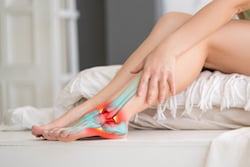Takeaways From a Retrospective Cohort Study
What's your current approach to treating patients who suffer from Achilles tendinopathy?
Among foot/ankle injuries, Achilles tendinopathy is a prevalent condition treated in sports medicine today. It is a painful condition that arises as a result of repeated tears to the tendon fibers. Those who suffer from Achilles tendinopathy may experience pain, swelling, stiffness, and limited mobility.
The Achilles tendon joins the heel bone to the calf muscles. Repeated tiny injuries to the Achilles tendon have a negative impact, and the damage can occur due to overuse of the tendon (52% occurrence in runners). While the injury is notorious among runners, other athletes are also impacted. Perhaps the most surprising news is that one-third of those with AT lead a sedentary lifestyle.
Standard Treatment Protocols for Achilles Tendinopathy Patients
The line-up of standard treatment for Achilles tendinopathy may include:
- Physical Therapy
- Eccentric loading
- Stretching
- Heel Lifts
- Rest (Avoidance of painful activities)
- Icing
- Non-steroidal anti-inflammatory drugs
- High-volume injection with steroid plus eccentrics
- Surgical treatments ONLY when conservative methods have failed
For most people, the symptoms of Achilles tendinopathy are usually resolved within 3-6 months after starting treatment.
Patients seeking relief from the pain and inflammation present in this debilitating condition are looking for ways to get back to an active, healthy lifestyle.
Increasingly, physicians are turning to regenerative medicine technologies like FSWT (Focused Shockwave Therapy) and RSW (Radial Sound Wave, also known as Radial Pressure Wave) and/or a combination of the two shockwave therapies for a novel non-invasive approach.
Evaluating Radial Shockwave or Combined Shockwave Approach
A retrospective cohort study by David M. Robinson, MD, Can O. Tan, Ph.D., and Adam S. Tenforde, MD, all of Spaulding Rehabilitation Hospital/Harvard Medical School, was published in The Journal of Foot & Ankle Surgery. The study titled "Functional Gains Using Radial and Combined Shockwave Therapy in the Management of Achilles Tendinopathy" takes a comprehensive look at findings from a quality improvement initiative evaluating the safety and functional outcomes after treatment with radial shockwave therapy or combined shockwave therapy (radial + focused) for patients with AT resistant to exercise therapy.
While shockwave has been shown to improve function in AT patients in numerous studies, until now, there has not been a study comparing RSW to a combination of both RSW and FSW and reveals outcomes related to the treatment of Achilles tendinopathy.
At the outset, the authors hypothesized that patients receiving RSWT and CSWT (combined shockwave therapy) would see an improved function with similar safety outcomes. Some patients elected to receive CSWT after not achieving satisfactory results with RSWT.
Patients and Methodology of the Retrospective Cohort Study
The Department of Physical Medicine and Rehabilitation at Spaulding Rehabilitation Hospital approved this quality improvement initiative and the Institutional Review Board (IRB) approval was waived for this study. Researchers followed SQUIRE-2 guidelines for reporting quality improvement data.
Data collection procedure:
- Data chart review from 9/2017-9/2020 from 2 Authors (David M. Robinson, MD, and Adam S. Tenforde, MD)
- Patients reviewed received RSWT or ESWT for either insertional or mid-portion AT at the senior author, Adam S. Tenforde, MD, sports medicine clinic.
- Data includes clinical and treatment characteristics, demographics, and functional outcome measures of VISA -A.
- AT diagnosis was based on history and physical examination, and imaging to exclude alternative conditions
- Inclusion criteria
- Achilles tendinopathy as the primary diagnosis (insertional or mid-portion)
- History of treatment with physical therapy or medical practitioner and completed eccentric heel drops as prescribed
- Symptoms > 3 months
- Available baseline and follow-up functional outcome measures
- Exclusion criteria
- History of Achilles tendon surgery
- Myotendinous Achilles pain
- Presence of connective tissue or inflammatory disease (i.e., rheumatoid arthritis
- Other co-occurring lower extremity injuries at the time of treatment
Treatment Procedure and Devices Used
All patients received treatment with RSWT or CSWT. From August 2017 to January 2019, the clinic performing ESWT used RSWT solely. In January 2019, CSWT was introduced and offered to patients as an alternative to RSWT. Shockwave was used over a minimum of 3 weekly sessions, with additional sessions added as needed to maximize clinical outcomes.
The STORZ Medical EPAT device, the OrthoPulse Ultra 100, was used for all RSWT treatments, using 2 applicator heads each for a minimum of 3000 strikes at 15 Hz and set for a minimum pressure was 1.8 (range 1.8-4.5) Bar applied over areas of pain.
The STORZ Medical focused shockwave device, the DuoLith, was used for CSWT treatments set at a minimum of 1000 shocks at the energy of 0.1 (range 0.1-0.45) mJ/mm2. Targeting was primarily applied to the Achilles tendon and RSWT over the myotendinous region and affected muscles for a minimum of 3000 strikes at 15 Hz and set for a minimum pressure of 2 (range 2-4.5) Bar.
For patient comfort and clinical focusing, the settings of each shockwave device were adjusted accordingly.
Achilles Tendinopathy Treatment Outcomes and Conclusions
As hypothesized, the study confirms the majority of patients receiving RSWT alone and those receiving combination shockwave therapy experienced clinical improvement with shockwave treatment. All had been previously resistant to physical therapy treatment for relief of Achilles tendinopathy.
In conclusion, the findings collectively suggest that most patients suffering from chronic AT may achieve functional gains using ESWT.
Adding Shockwave to Your Continuum of Care for Patients and Practice ROI
Functional gains and impressive outcomes are meaningful to patients with Achilles tendinopathy and other challenging conditions and injuries. Become the trusted resource for eliminating pain and dysfunction with shockwave. Regenerative technologies like shockwave and EMTT are game-changers for patient outcomes and practice growth.
Interested in expanding the boundaries of patient care with innovative, evidence-based, non-invasive technologies, products, and procedures from CuraMedix?
Have questions? Contact us today, and we'll connect you with one of our shockwave experts.




